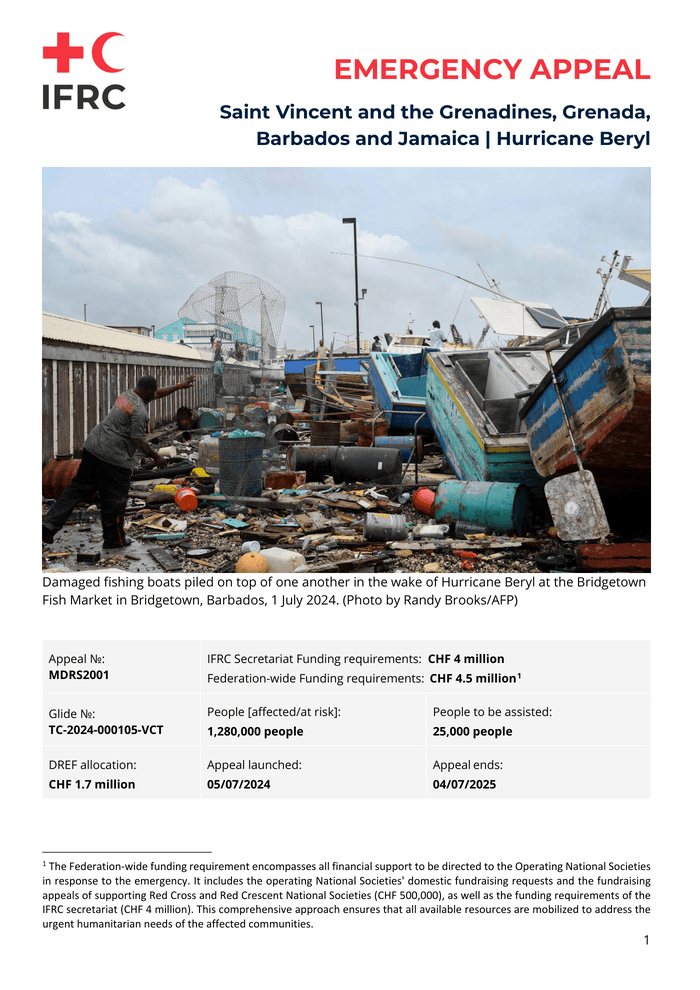Attachments
Glide №: TC-2024-000105-VCT
SITUATION OVERVIEW
On 25 June, the National Hurricane Centre began monitoring a tropical wave with the potential for development that was moving westward. By 28 June, already transformed into Tropical Depression 2 (system AL95), it began to intensify due to atmospheric conditions and officially became Tropical Storm Beryl.
The final conditions for it to become a hurricane occurred on 29 June, making it the first major hurricane of the 2024 Atlantic hurricane season and the earliest Category 4 hurricane to form in recorded history, on 30 June. By 1 July, it became a Category 5 hurricane with maximum sustained winds of 270 km/h. It is important to remark that Beryl is only the second storm and first hurricane of the season. NOAA forecast predicts an 85% chance of an above-normal season, exceptionally active, with a range of 17 to 25 total named storms. Of those, 8 to 13 are forecast to become hurricanes (winds of 74 mph or higher), including 4 to 7 major hurricanes (category 3, 4 or 5; with winds of 111 mph or higher).
This forecast, plus El Niño phenomenon and the climate change increases the risk of stronger storms and puts the Caribbean in high risk. There is a stronger link to climate change driving larger storms and faster intensification, which means more damage and less preparedness time for National Societies.
According to the forecasts, it is likely that before this response is finished, the same countries affected by Beryl will have to respond to other climate-exacerbated shocks and stresses. These will arrive on people already put in more vulnerable positions by this event.
Hurricane Beryl made landfall on 1 July in Grenada and Saint Vincent and the Grenadines as a Category 4, causing three deaths in Grenada and three deaths in Saint Vincent. According to the Prime Minister of Saint Vincent and the Grenadines, 90% of the houses on Union Island have been severely damaged or destroyed. Also, as reported by UN OCHA, an estimated 200,000 people have been affected in both Saint Vincent and the Grenadines and Grenada, representing 100% of the population. According to media reports, approximately 1,752 people in Saint Vincent and the Grenadines are currently in 71 public hurricane shelters. Hundreds of homes in Saint Vincent were also severely affected, including government buildings and several churches.
In Grenada, more than 1,600 people are in shelters, a number that is expected to double.
More than 98 per cent of the buildings has been severely affected in the Union, Carriacou and Petit Martinique islands, where most of the health facilities are compromised, as well as the terminal building Carriacou airport, and in general the majority of buildings, including schools and petrol stations, are damaged or destroyed.
Beryl also impacted Barbados on 1 July. The Barbados Red Cross reported on the IFRC GO platform that 208,200 people were affected by the storm, representing almost 74% of the total population. Reports indicate 40 homes with some type of damage, loss of roofs, partial collapse, or damage such as roof leaks. In terms of livelihoods, all boats at the Bridgetown marina sustained damage, and several completely sank due to large waves. According to government, damage assessments will be carried out in the coming days to determine the losses of the fishing industry.
Hurricane Beryl intensified to a category 5 as it approached Jamaica, bringing with it the potential for severe impacts. The full extent of damage still to be assessed. Reports indicate extensive damage, including numerous fallen trees that have blocked roads, landslides, widespread power outages in multiple communities, and structural damage due to high winds. The main power provider is having difficulties in restoration efforts to the widespread blackouts. This has exacerbated the situation by complicating rescue and relief efforts due to widespread power outages and infrastructural damages. Furthermore, the storm has significantly affected emergency operations, disrupting transport, communication, and public health services across the island. Around 59 shelters are activated with about 1,000 people, and more than 400,000 people have been affected by power outages.
The media reports 10 fatalities as of 5 July: three in Grenada, three in St. Vincent and the Grenadines, three across Venezuela – where five people are still missing – and two in Jamaica.
For the 4 countries of this emergency appeal, the population affected by Beryl is 1.28 million.
The hurricane hit however several other countries in the Caribbean and the mainland, affecting an average of 3.5 million persons. Beryl has made landfall in the Yucatán Peninsula and is expected to move into the Bay of Campeche on Friday evening.
As of this date, information is limited, as assessments have just commenced. Damage reports, and more precise figures, are expected to be available in the coming days.
While not a threat in terms of becoming a fullblown system, it should be noted that further forecasted tropical waves will bring significant rainfall to the islands already impacted by the passage of Hurricane Beryl. The additional adverse weather will likely hamper initial relief efforts and exacerbate already strained conditions on the ground.
Source link : https://reliefweb.int/report/grenada/saint-vincent-and-grenadines-grenada-barbados-and-jamaica-hurricane-beryl-emergency-appeal-no-mdrs2001
Author :
Publish date : 2024-07-05 21:33:10
Copyright for syndicated content belongs to the linked Source.
